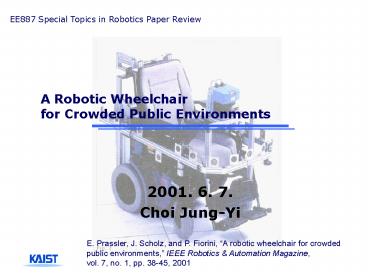A Robotic Wheelchair for Crowded Public Environments - PowerPoint PPT Presentation
Title:
A Robotic Wheelchair for Crowded Public Environments
Description:
Title: Switching Converters Author: Last modified by: Marek Perkowski Created Date: 12/12/1999 11:17:04 AM Document presentation format – PowerPoint PPT presentation
Number of Views:58
Avg rating:3.0/5.0
Title: A Robotic Wheelchair for Crowded Public Environments
1
A Robotic Wheelchair for Crowded Public
Environments
EE887 Special Topics in Robotics Paper Review
- 2001. 6. 7.
- Choi Jung-Yi
E. Prassler, J. Scholz, and P. Fiorini, A
robotic wheelchair for crowded public
environments, IEEE Robotics Automation
Magazine, vol. 7, no. 1, pp. 38-45, 2001
2
Overview
- Two difficult situations of using wheelchair
- Form conversations with the user community
- Navigation in
- NARROW CLUTTERED environments
- WIDE CROWDED areas
- MAid (Mobility Aid for Elderly and Disabled
People) Combines - Narrow Area Navigation (NAN) Behavior
- ? Semiautonomous Navigation Mode
- Wide Area Navigation (WAN) Behavior
- ? Autonomous Navigation Mode
3
Hardware Design
- Mechanical Part
- Rear wheels two differentially driven
- Front wheels two passive castor
- Maximum speed 6 km/h (Powered by 12 V battery)
4
Hardware Design
- Central Processing
- Industrial PC(Pentium 166 MHz) QNX
- Sensors
- Dead-reckoning system wheel encoders optical
fiber gyroscope - 3 x 8 Ultrasound transducers and microcontrollers
- Short-range sensing two infrared scanners
- 2-D laser range-finder
5
Hardware Design (Contd)
6
Control Architecture
- WAN Hierarchical Control Architecture
Strategic Level
Tactical Level
Basic Control Level
7
Basic Control Level
8
Tactical Level (Overview)
- The core of WAN Module
- Motion Detection
- Motion Tracking Obstacle Velocity Estimation
- Computation of the Evasive Maneuvers
9
Tactical Level (Overview) contd
- Monitoring the surrounding environment
- Detect the environment objects
- Identify stationary / moving object
- Sonar system
Laser range finder
- Estimate the speed and direction of the object
Past trajectory and velocity
- Determine if MAid is moving on s collision course
with objects - Compute the avoidance maneuver
10
Strategic Level
- Main task
- Navigating in crowded area
- Reaching a specific goal
- Without any intermediate goal
- Selection the nest motion goal by the user
- Strategic level will be expended by including a
path planner capable of adding the computation of
subgoal sequences
11
Motion Detection and Tracking
- A sequence of single observation
- Investigating where these observations differ
from each other - Discrepancy ? potential change
- Occupancy Grid Representation
- A projection of the range data on a 2-D
rectangular grid - Grid element ? a small region of the real world
- Updating every cell ? time consuming process
12
Time Stamp Map
- Modification of occupancy grid representation
- Map only cells observed as occupied
- Cell coinciding with the range measurement
- All other cells ? left untouched
- Range image ? 200 x 200 time stamp map
- Takes 1.5 msec on a Pentium 166 MHz
13
Motion Detection Algorithm
- Based on a simple heuristic
- Cell is occupied
- by a stationary object if corresponding cells in
TSMt and TSMt-1 carry time stamps. - By a moving object if corresponding cells in TSMt
carry a time stamp different from TSMt-1 or no no
time stamp at all. - TSMt Time Stamp Map at time t
14
Motion History
- Objects are represented by cell ensembles in the
sensor map. - Identifying the object in a sequence of maps
- Correspondence between objects
- ? using a nearest-neighbor criterion based on a
Euclidean distance - The ensembles describes the same object
- ? if the distance to the nearest neighbor is
smaller than a certain threshold. - Threshold
- For stationary object 30cm
- For moving object 1 m
15
Motion Planning
- For simplicity
- Model the wheelchair and the obstacles as
circles. - ? Planar problem with no rotations
obstacle
Wheelchair
16
Velocity Obstacle
- VO of A with respect to B
- Identifying the set of velocities of A causing a
collision with the obstacle B at some time - To avoid collision selecting the tip of VA
outside VO
17
Velocity Obstacle (contd)
- Collision Cone v.s. Velocity Obstacle
- Avoiding multiple obstacles
- Prioritization among Vos
18
Velocity Obstacle (contd)
- Consideration of wheelchair dynamics
- Some heuristics for making trajectory
Reachable Avoidance Velocity
Velocity Obstacle
Reachable Velocity
Toward Goal
Maximum Velocity
Structure
19
Experiments in Real Situations
- Roaming in a Railway Station
- Hall size 20 x 40 m2
- Several tens of people
- Survived about 18 hours
- Hannover Fair 98
- Survived more than 36 hours































